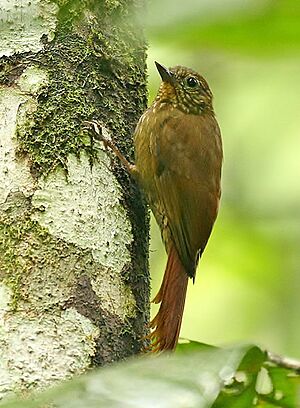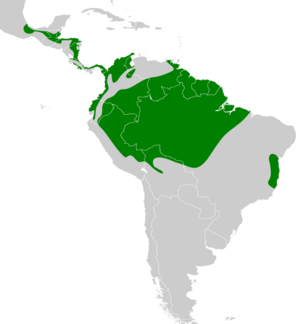Wedge-billed woodcreeper facts for kids
Quick facts for kids Wedge-billed woodcreeper |
|
|---|---|
 |
|
| at Rio Silanche (PVM), NW Ecuador | |
| Conservation status | |
| Scientific classification | |
| Genus: |
Glyphorynchus
|
| Species: |
spirurus
|
 |
|
| Synonyms | |
|
|
The wedge-billed woodcreeper (Glyphorynchus spirurus) is a small bird found in many parts of Central and South America. It belongs to the ovenbird family called Furnariidae. This bird is known for its unique, wedge-shaped bill.
Contents
About This Bird
What It Looks Like
The wedge-billed woodcreeper is the smallest of all woodcreepers. It has a short, slightly upturned bill that looks like a wedge. This bird is about 13 to 16 centimeters (5 to 6 inches) long. It weighs between 10.5 and 21 grams (0.4 to 0.7 ounces). Both male and female birds look very similar.
The main type of this bird, called G. s. spirurus, has a grayish forehead. Its head and neck are a rich brown color. It has light buff (pale yellowish-brown) markings around its eyes and a thin stripe above them. Its back and shoulders are rich brown, while its lower back and tail are a cinnamon-red color. Its wings are mostly dark brown with reddish parts. When it flies, you can see a light stripe on the underside of its wings.
The bird's throat is whitish-buff with some dark spots. Its belly is olive-brown to reddish-brown. Its upper chest has large round spots, and its lower chest has narrow streaks of the same color. Its eyes are dark brown, and its bill is black with a gray base. Its legs and feet can be pinkish-gray, dark gray, or brownish-black.
Other types of wedge-billed woodcreepers have slight differences in their colors and markings. For example, some have darker bellies or different colored throats.
Where It Lives
The wedge-billed woodcreeper lives in many countries. These include Mexico, Central America, and a large part of South America. You can find it in places like Brazil, Bolivia, Ecuador, and Venezuela.
This bird mostly lives in tropical evergreen forests, including rainforests. It prefers the inside of old, mature forests. You might also see it at the edge of forests or in older secondary forests (forests that have grown back after being cut down). Sometimes, it can be found in bamboo patches or even in open areas with a few trees.
It lives at different heights depending on the region. In Central America, it can be found up to about 1,500 meters (4,900 feet) above sea level. In some parts of South America, it can live even higher, up to 2,100 meters (6,900 feet).
How It Behaves
Movement
Most wedge-billed woodcreepers stay in the same area all year round. They do not usually migrate long distances.
Feeding
This bird often forages in pairs. It also joins mixed-species feeding flocks, which are groups of different bird species that feed together. It usually looks for food in the lower and middle parts of the forest.
The wedge-billed woodcreeper mainly eats very small arthropods (like insects and spiders). It finds its food by climbing up tree trunks or along branches. It picks prey from cracks in the bark, moss clumps, or by flaking off pieces of bark. It can also tap on wood to find food.
Life Cycle
The breeding season for the wedge-billed woodcreeper changes depending on where it lives. For example, in Costa Rica, they breed from March to June. In parts of Brazil, they might breed from September to December or February to June.
They build a cup-shaped nest using fine plant fibers. The nest is usually placed inside a hole in a tree trunk or stump. Sometimes, they use holes made by woodpeckers. Nests are typically found within 6 meters (20 feet) of the ground, often much lower.
A female bird usually lays two eggs. We don't know how long the eggs take to hatch. However, the young birds leave the nest about 17 days after hatching. Both parents help to incubate the eggs and care for the baby birds.
Vocalization
The wedge-billed woodcreeper sings mostly in the early morning and late evening. Sometimes, it sings during the day too. The songs can sound different depending on the specific type of woodcreeper.
For example, some types in Central America sing a fast, bubbly series of notes that go up in pitch. It might sound like "twee-lee-lee-le-le-ee-ee-eeeeeé". Other types in the Amazon sing clearer whistles that go up more slowly, like "too-e too-e tu-tu-tu-tue’tue’twu’tweetwee". Birds in the southeastern part of their range sing two short, clear whistles, like "treeee, treep".
Their calls are more similar across all types. They can make sounds like "pweek!", "cheeyf!", "chiff!", or "djeep!".
Conservation Status
The IUCN (International Union for Conservation of Nature) has listed the wedge-billed woodcreeper as being of "Least Concern." This means that it is not currently at high risk of disappearing.
This bird lives in a very large area. Scientists estimate there are at least 500,000 adult birds, but this number is thought to be going down. No major immediate threats have been found for the species as a whole. In many places, it is considered fairly common.
Even though it prefers old forests, it can survive in areas where forests have been disturbed or in smaller forest patches. This suggests it is not as sensitive to changes in its habitat as some other woodcreepers. However, its numbers might be lower in disturbed forests.


